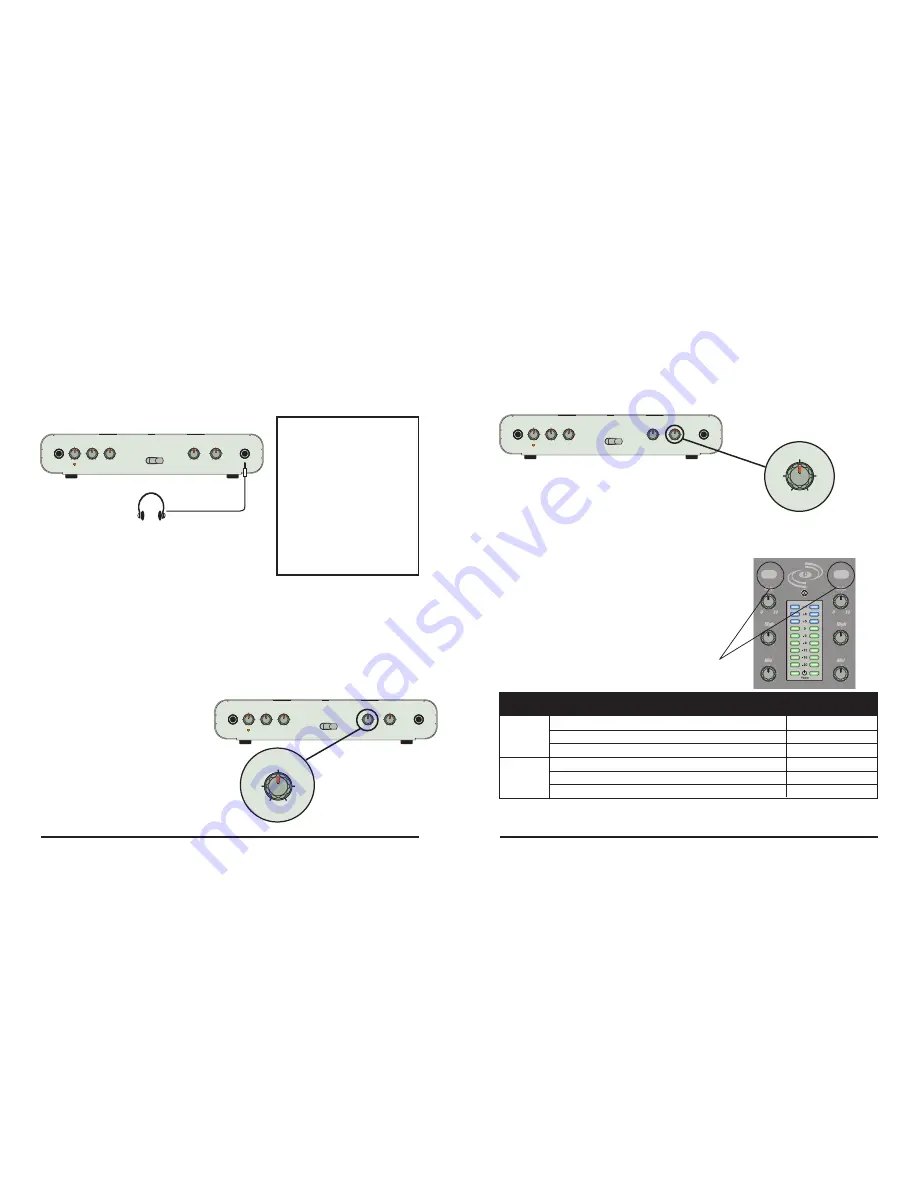
3. Set the desired audio input source’s volume to its minimum setting,
turn it on, and set it to play (or speak continuosly into the microphone).
4. Slowly turn the CUE LEVEL control clockwise until you hear the signal
through the headphones at the desired volume level.
5. Repeat Steps 2-4 to select and adjust the volume level of the other
audio input sources, one at a time.
MIC On
MIC Volume
High
Low
Cue Volume
Phones
0 10
Cue 2
Mix
0 10
-dB +dB
-dB +dB
Fader Reverse
On
Off
MIC
Cue 1
MIC On
MIC Volume
High
Low
Cue Volume
Phones
0 10
Cue 2
Mix
0 10
-dB +dB
-dB +dB
Fader Reverse
On
Off
MIC
Cue 1
MIC On
MIC Volume
High
Low
Cue Volume
Phones
0 10
Cue 2
Mix
0 10
-dB +dB
-dB +dB
Fader Reverse
On
Off
MIC
Cue 1
Pyle Pro Mixer Owner’s Manual – 5
4 – Pyle Pro Mixer Owner’s Manual
Plug a pair of stereo headphones (not supplied) with a 1/4” jack into the Phones input. Using
headphones not only affords you the opportunity to listen privately, but also enables you to monitor
the incoming audio sources so you can locate an exact passage or section before mixing it in. It also
gives you the opportunity to set up the relative volume level of the upcoming passage before it joins
the mix.
Using Headphones
Do not listen at extremely high
volume levels.
Extended, high-volume
listening can lead to permanent hearing
loss. Follow these guidelines to protect
your hearing, especially when using
headphones.
Always start by setting the volume
level to the lowest possible level
before listening.
Put headphones on, and then
gradually increase the volume as
necessary.
Once you set the volume level do
not increase it.
Over a period of time,
your ears adapt to a volume level and
there is a temptation to increase it.
Even though such an increase may not
cause discomfort, it might still damage
your hearing.
Listen Safely! Please observe the following:
Using the Mixer Controls
Turning on the Mixer
1. Turn on the output amplifier and temporarily set its volume to the minimum setting.
2. On the mixer, turn ON the power switch. The adjacent power LED will illuminate.
3. Turn on the audio input sources you wish to mix, and set them to play (or talk continuously into
the microphone).
4. To monitor the audio input sources so that you can decide when to mix in each input, see “Monitoring
‘Cueing’ the Inputs.”
5. To mix the audio input sources so that you can play them through your amplifier system or record
them on your tape deck, see “Mixing the Inputs.”
Cue 2
Mix
Cue 1
CUE Mix
Monitoring (”Cueing”) the
Inputs
Follow these steps to monitor the audio input
sources.
1. Perform Steps 1 and 2 of “Turning on the
Mixer” and put headphones on.
2. Set the CUE Mix to the channel you wish
to monitor (CH 1 or CH 2).
Cue Volume
0 10
2
CUE Level
Control
Mixing the Inputs
Follow these steps to mix the audio input
sources.
1. Perform Steps 1 and 2 of “Turning on
the Mixer.”
2. Set the selected audio input source’s
volume to its minimum setting, turn
it on, and set it to play (or speak
continuously into the microphone).
3. Set the following input source selectors
as desired:
Turntable connected to INPUT 1 jacks
Or high level output audio source connected to the INPUT 1 jacks
The iPod inserting to the iPod 1 dock
Turntable connected to INPUT 2 jacks
High level output audio source connected to the INPUT 2 jacks
The iPod inserting to the iPod 2 dock
Mixer
Channel
Audio Input
Source
Input Selector
Switch Setting
1
PH1/LN1
PH1/LN1
iPod 1
PH2/LN2
PH2/LN2
iPod 2
2
Input Source
Selector Switches
Stereo
Headphones
iPod 2
Ph 2
Ln 2
iPod 1
Ph 1
Ln 1
-dB
+dB
-dB
+dB
-dB
+dB
-dB
+dB
























